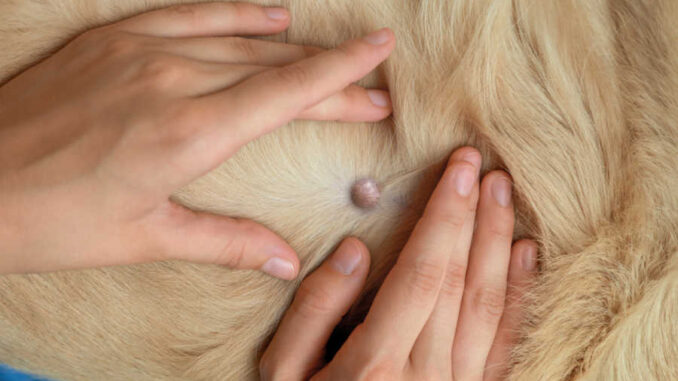
This article was updated on September 19th, 2023
As a practicing veterinarian for over 17 years, I have treated hundreds of dogs with cysts. Cysts are a very common presenting complaint from dog owners and can understandably be concerning. The good news is that they are benign and typically easily taken care of.
About Dog Cysts: A Quick Overview
Cysts on dogs may have many different appearances, as shown on the pictures below:
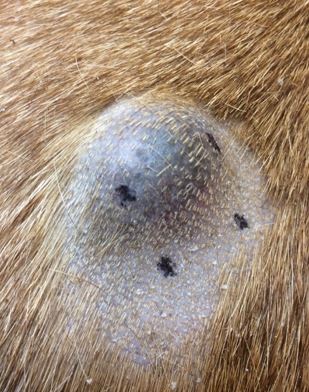
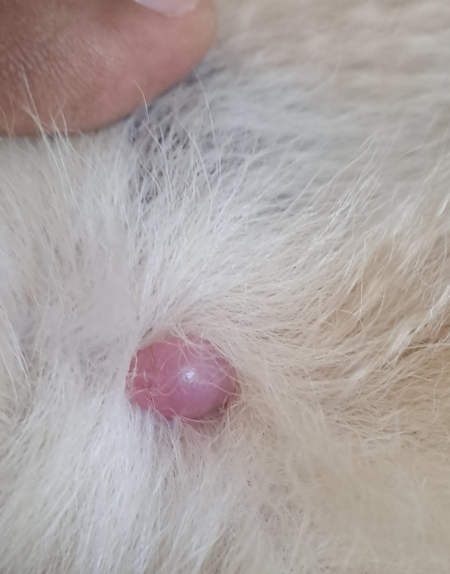

They tend to be liquid filled, squishy, and soft. A true cyst is a hollow area within the tissues that contain liquid or solidified bodily fluids.
The most common type is sebaceous cysts: they contain sebum, which is an oily, waxy substance secreted by the dog’s sebaceous glands. Sebaceous cysts also often contain bits of dead skin cells and keratin.
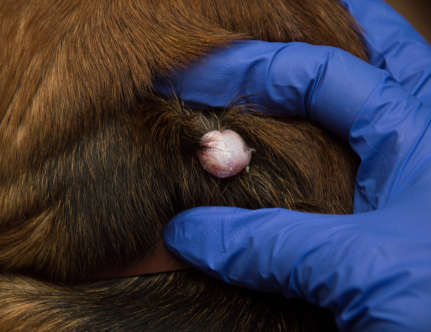
Other types of cysts found on dogs include true, false, follicular, interdigital, and dermoid cysts. Remember that to be a cyst there must be a hollow cavity within the mass that holds a liquid or dried liquid substance.
The prognosis is excellent, but the treatment will depend on the type and the location. Some cysts can be treated with benign neglect, meaning that no treatment is necessary. Others will require surgical removal.
6 Types of Cysts on Dogs (with pictures)
1. Sebaceous Cysts
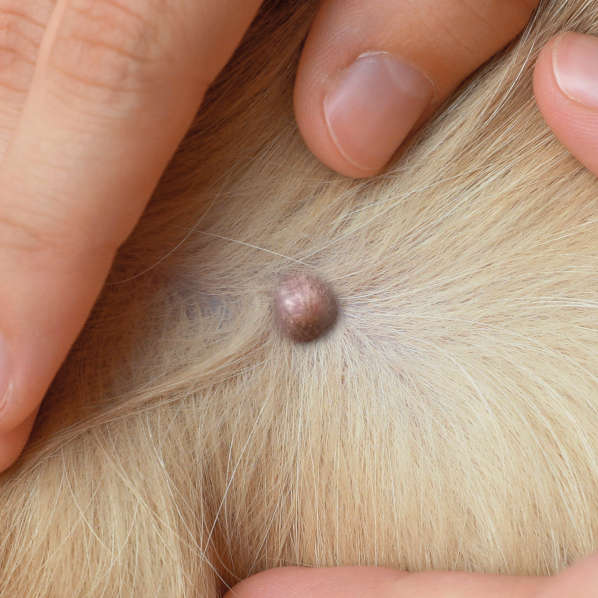
Sebaceous cysts are very common in dogs. These cysts are hollow spaces filled with sebum. They develop inside and near the sebaceous glands in the dog’s skin. These glands are located under and around the hair follicles and serve to moisturize and protect the skin barrier. Due to their superficial location in the top layer of skin, they are particularly prone to secondary bacterial infection. They are common in many breeds of dogs, but especially the schnauzer breed.
Sebaceous cysts are benign and can be left alone in many cases. If they rupture, become infected, or bother the dog, then surgical removal is the only effective treatment.
Cysts should never be “popped” as this will not remove the cells that created the cyst, leading to likely recurrence. Infection and pain are also consequences of attempting to “pop” a sebaceous cyst. There is no home remedy for cysts. Learn more about sebaceous cysts (with pictures).
2. True cysts
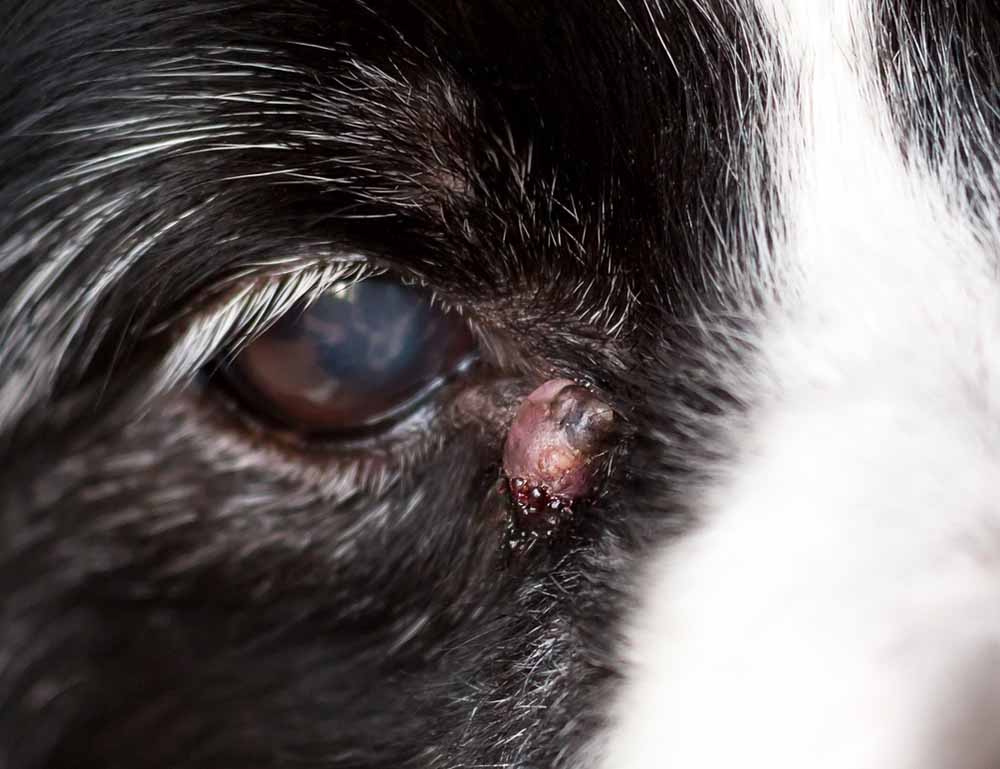
True cysts are the type that most people think of when they think of a cyst. These are termed “true” because they have a secretory lining that produces a liquid filling. These secretory cells line the inside of the cyst in 360 degrees. This is important to note when discussing the removal of a true cyst: if the entire secretory lining is not removed surgically, the cysts will reform, as the remaining cells of the lining produce cystic fluid again.
True cysts are often a result of blocked ducts, typically near the eye and the eyelids. They also must be tested, via a fine needle aspirate or biopsy, by your veterinarian to confirm that they are truly benign. If diagnosed as a true cyst, surgical removal is the only cure. However, if it is not bothering the dog, your veterinarian may recommend watching it to see if it will resolve on its own with time.
3. False Cysts
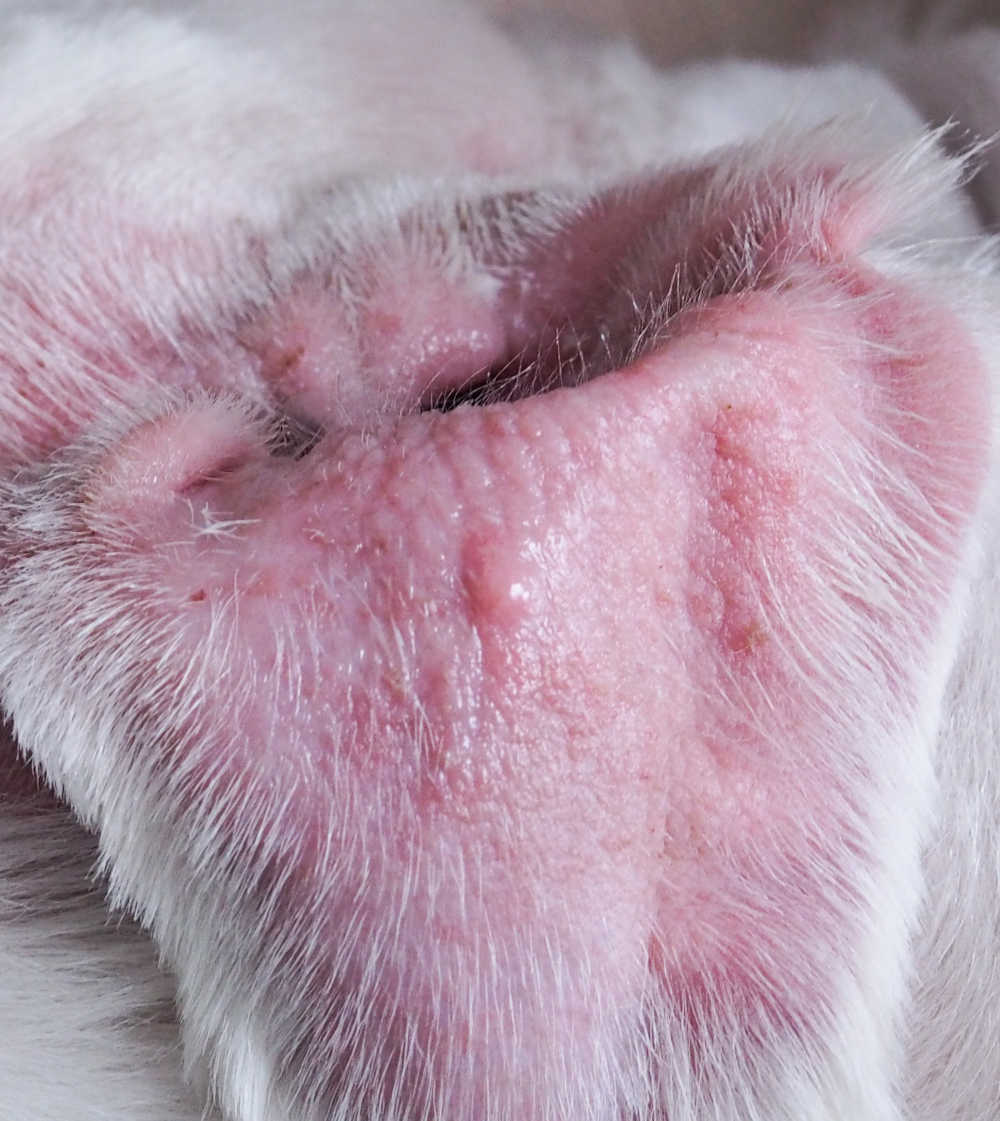
False cysts are fluid-filled masses or areas in the tissue that are not truly “cysts” because they do not contain a secretory lining. The most common cause is bleeding under the skin due to trauma. Often the trauma results in an area of dead tissue that then fills with blood and necrotic tissue. If on the trunk or legs, these cysts are commonly seen in dogs that have suffered blunt force trauma, such as being hit by a car. Aural hematomas like the one in the picture above are caused by trauma to the ear pinna, often as a result of the dog scratching an infected ear.
False cysts may or may not need to be treated. They typically resolve on their own, but the dog will likely require pain medications and antibiotics to prevent infection. However, if a dog has sustained an injury that is severe enough to cause a false cyst, they need to be taken to a veterinarian for care.
4. Follicular cysts
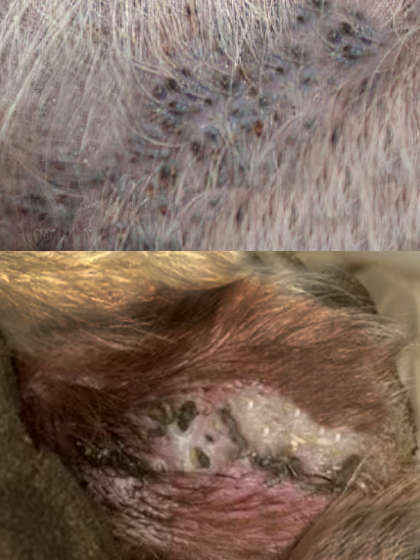
Follicular cysts are sometimes mistaken for sebaceous cysts, but they are different. Though located in the same areas, they are actually dilated hair follicles. The hollow area that forms around the hair’s follicle contains dark-colored fluid or a clumpy granular material. Follicular cysts appear as “blackheads” in most cases and are often surrounded by red, inflamed, or infected areas of skin. They are common in dogs that have bacterial skin infections resulting from allergies.
Follicular cysts typically resolve when the underlying skin condition is treated and managed successfully. Skin infections will typically be treated with oral antibiotics and topical shampoos. If the infection is a result of allergies, the allergies must be aggressively managed in order to prevent a recurrence. View more pictures of follicular cysts.
5. Interdigital Cysts
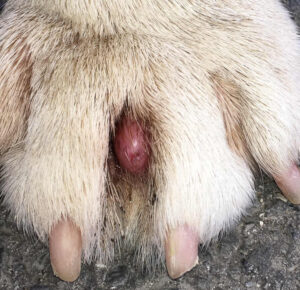
Interdigital cysts are found on the feet, between the toes. These lesions are areas of deep infection that form in response to chronic inflammation. They occur most commonly in larger, overweight dogs but can occur in any dog, especially if they are a result of a foreign body such as a sticker or grass awn in the paw.
Treatment involves surgical removal, foreign body removal, weight loss, antibiotics, and anti-inflammatory medications. Learn more about interdigital cysts or lumps on dog paws.
6. Dermoid cysts
Also known as dermoid sinuses, dermoid cysts are cysts or communications with the spine that form when the puppy is a fetus. They are found along the backbone and occur because the outer layer of the skin (termed the epidermis) fails to close completely over the back. These are neural tube defects, and these dogs should not be bred.
Dermoid cysts are rare in dogs and are typically identified at birth. They are most commonly seen in Rhodesian Ridgeback dogs. Click here to view a picture of a dermoid cyst. Treatment of dermoid cysts consists of surgical closing of the defect shortly after birth.
Can I just monitor my dog and wait to see how it evolves?
Yes, to some extent. The first step in addressing a suspected cyst on a dog is to have your veterinarian definitely determine that it is, in fact, a cyst. Many growths on dogs that owners mistakenly assume are cysts or benign lumps are truly cancerous tumors. Waiting and watching these masses can have catastrophic consequences.
If you have pursued veterinary advice and testing and are sure that the mass is indeed a cyst, there are situations where it can be left alone. If it is small and is not bothering the dog, it may be left alone as long as there are no complications. Rupturing, enlarging, or infection are all complications that may necessitate surgical removal. Any change in the cyst should also trigger a visit to the veterinarian to ensure the mass has not become cancerous.
Are cysts painful or uncomfortable to the dog?
They are typically not painful nor uncomfortable to dogs. If they appear to be bothering your dog (they are licking or scratching at the area), you should make an appointment with their veterinarian.
Signs that your dog’s cyst needs veterinary intervention:
- Initial diagnosis to ensure it is a cyst
- Redness
- Swelling
- Irritation
- Growth
- Rupture
Diagnosis by your veterinarian
Because any abnormal lump found on a dog could be cancer, every lump should be tested as soon as it is found. Your veterinarian will perform either a fine needle aspirate or a biopsy of the mass to determine what it is. A fine needle aspirate can typically be performed without sedation at an office visit and involves aspirating some cells from the mass and examining them under a microscope.
Though minimally invasive and rapid, it is important to note that few cells are sampled with this method, and there is a risk of misdiagnosis. A biopsy typically requires the dog to be sedated, and a section of tissue from the mass is removed and sent to a veterinary pathologist for diagnosis.
Though more accurate than the FNA, a biopsy is unable to look at the entire mass and also carries the risk of misdiagnosis. Depending on the mass and the owner’s preferences, it may be more cost and time effective to simply surgically remove the entire mass and then send it to the veterinary pathologist for evaluation. This reduces the number of procedures necessary and also is the best chance for a complete cure.
Treatment of cysts & removal
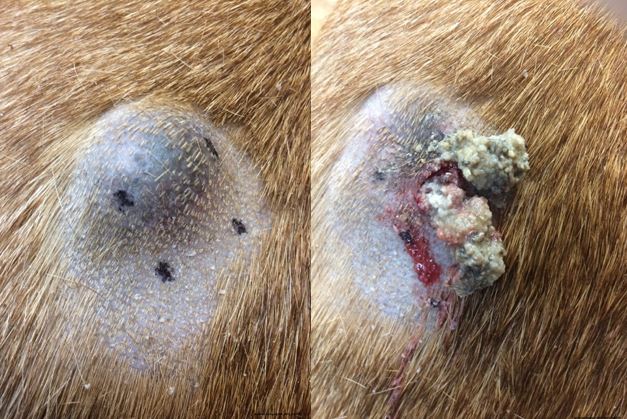
The most common treatment is surgical removal. If the entire cyst is successfully removed, it will not recur. Some cysts, especially those caused by a skin infection, may be treated with either oral or topical antibiotics. Cysts caused by trauma may resolve on their own in time.
The cost of surgical removal will vary depending on the dog’s age, size, and health, as well as the size, type, and location. Costs for surgical removal with histopathology and medications may range from $300-$1000.
What causes cysts?
Cysts are typically a result of injury or irritation to the area of the skin where they develop. Chronic skin infection blocked ducts of glands and repeated rubbing, or pressure on an area may all be the underlying culprit. Dermoid cysts are an exception to this as they are believed to be genetically linked and form when the puppy is a fetus.
Is there anything that dog owners can do to prevent future cysts?
In some cases, especially schnauzers and dogs with chronic skin allergies, cysts may recur even after successful treatment. These recurrences are not a result of the removed cyst coming back but instead are new cysts forming. This can be due to the breed’s disposition for the issue or a result of chronic skin irritation. To prevent future occurrences as much as possible, owners must address the underlying causes, such as allergies, skin infections, and ear infections.
What to do when cysts rupture, get infected, or bleed
If your dog’s cyst has ruptured, appears infected, or is bleeding, you must make them an appointment with their veterinarian as soon as possible. In the meantime, keep the area clean and do not allow the dog to lick it. You should never give any medications to your dog without guidance from your veterinarian, as many OTC and human medications are toxic to dogs or may interfere with the medications the veterinarian will need to prescribe when they see your dog.
FAQ: Is it a cyst or is it a cancerous tumor?
Tests are often required to confirm the true nature of a new lump or bump. Appearances can be misleading. For example, the picture below shows a soft, pink and raised lesion. The surface is ulcerated and bruised and there may well be a mild bacterial infection. It could be that this is a benign growth such as a cyst or a skin tag. However, an FNA or biopsy should be done to confirm diagnosis and rule out cancerous growths. The fact that the skin has reputed and there is bruising would make a cancer more likely. Click here to learn more about cancerous lesions or lumps.
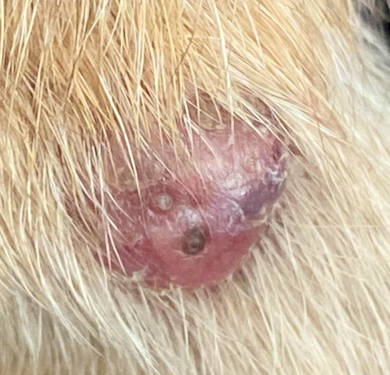
Related posts:
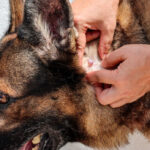 Types of Cysts Often Found on a Dog’s Neck or Head [Vet Advice] - Canine cysts of the head and neck are fairly common and most of them don’t cause serious problems. There are… [...]
Types of Cysts Often Found on a Dog’s Neck or Head [Vet Advice] - Canine cysts of the head and neck are fairly common and most of them don’t cause serious problems. There are… [...] 4 Cysts Often Found on Dog Paws [With Pictures & Vet Advice] - Ahh dog feet, giant Great Dane Marmaduke paws, tiny terrier tootsies, the puffy, fluffy white feet of a Bichon Frisé.… [...]
4 Cysts Often Found on Dog Paws [With Pictures & Vet Advice] - Ahh dog feet, giant Great Dane Marmaduke paws, tiny terrier tootsies, the puffy, fluffy white feet of a Bichon Frisé.… [...]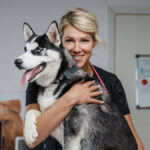 Eyelid Cysts in Dogs: FAQ With Our Veterinarian - Eyelid cysts are very common, particularly in older dogs. Oftentimes, an owner is unaware that they’re present as they can… [...]
Eyelid Cysts in Dogs: FAQ With Our Veterinarian - Eyelid cysts are very common, particularly in older dogs. Oftentimes, an owner is unaware that they’re present as they can… [...]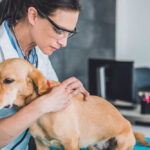 Burst or Ruptured Cysts on Dogs: Our Vet Shares What to Do - When a dog does come into my clinic with a ruptured cyst, the owner can be quite alarmed by the… [...]
Burst or Ruptured Cysts on Dogs: Our Vet Shares What to Do - When a dog does come into my clinic with a ruptured cyst, the owner can be quite alarmed by the… [...]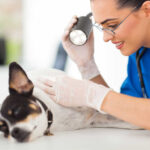 Dog Hair Follicle (Follicular) Cysts: Pictures + Vet FAQ - It is extremely common for dogs to develop lumps and bumps anywhere on their body. They can range in size,… [...]
Dog Hair Follicle (Follicular) Cysts: Pictures + Vet FAQ - It is extremely common for dogs to develop lumps and bumps anywhere on their body. They can range in size,… [...] Eye Cysts in Dogs: Pictures & Vet Advice - Introduction: about eye cysts in dogs Finding an unexpected growth or mass on your dog can be distressing, but it… [...]
Eye Cysts in Dogs: Pictures & Vet Advice - Introduction: about eye cysts in dogs Finding an unexpected growth or mass on your dog can be distressing, but it… [...]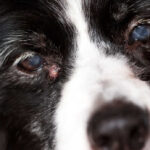 Sebaceous Cysts in Dogs [Pictures & Veterinarian Advice] - Sebaceous Cysts in dogs is one health issue for which dog owners should be watchful, but thankfully, they are rarely… [...]
Sebaceous Cysts in Dogs [Pictures & Veterinarian Advice] - Sebaceous Cysts in dogs is one health issue for which dog owners should be watchful, but thankfully, they are rarely… [...]Disclaimer: This website's content is not a substitute for veterinary care. Always consult with your veterinarian for healthcare decisions. Read More.

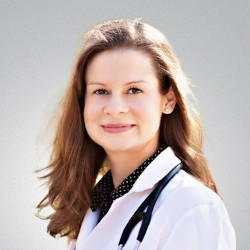
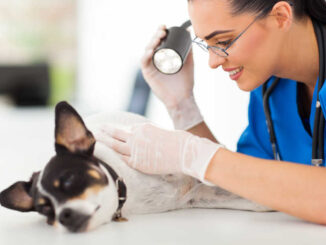


Be the first to comment